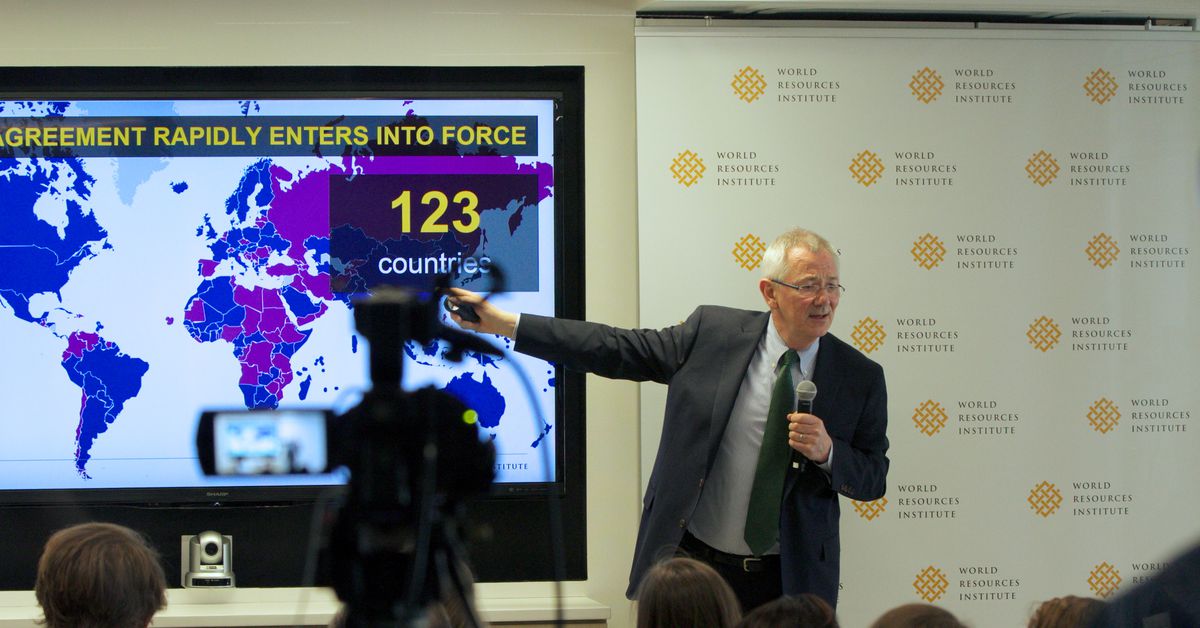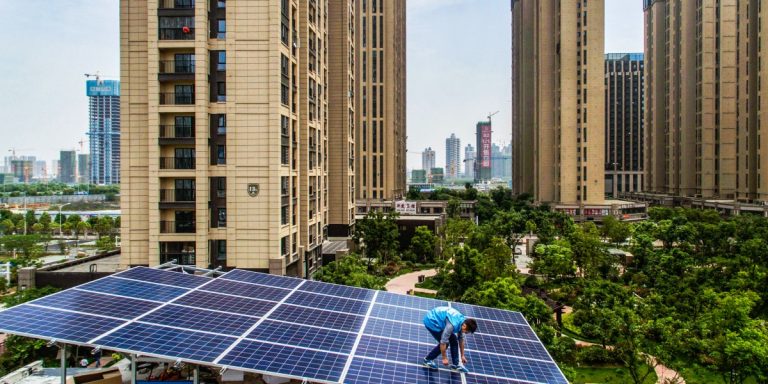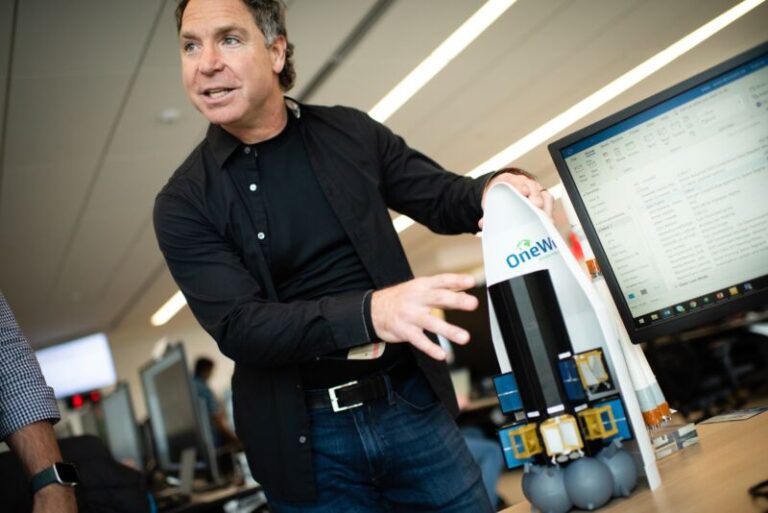
It’s a momentous week for action on climate change. On Thursday, the White House is convening 40 world leaders for an Earth Day summit where the United States is expected to announce new commitments to curb its greenhouse gas emissions. According to the Washington Post, the US is considering doubling its previous target, cutting emissions 50 percent below 2005 levels by 2030. In doing so, the US — the world’s second-largest greenhouse gas emitter — would end up committing to the largest cuts in emissions in the world.
Many other countries are also not sitting idle. Major economies like the United Kingdom, the European Union, and even China have their sights set on zeroing out their greenhouse gas emissions entirely. Others plan to ramp up their ambitions from the tepid goals set in the wake of the 2015 Paris climate agreement. The accord aims to limit warming this century to below 2 degrees Celsius compared to pre-industrial levels, with a more ambitious target of 1.5°C.
It’s been a struggle to get to this point, with decades of stops and false starts just to get countries to agree to limit climate change at all, not to mention the last four years of US backpedaling under Donald Trump. Now, scientists say the world has less than a decade to get on course for meeting the 1.5°C goal. Meanwhile, greenhouse gas emissions worldwide are poised to rise again this year as economies rebound from the Covid-19 pandemic.
Andrew Steer is a leading authority on international climate change policy and has been closely involved in the ebbs and flows of global action for more than a decade. He worked as a special envoy for climate change at the World Bank between 2010 and 2012. And until recently, he led the World Resources Institute (WRI), one of the premier think tanks on climate change and other environmental issues. WRI’s work has been indispensable for my own reporting, from their policy papers on energy to their visualizations to their briefings walking reporters through the intricacies of international climate negotiations.
Steer was recently poached by Amazon founder Jeff Bezos to lead the Bezos Earth Fund, one of the world’s largest climate philanthropies, pledging to spend $10 billion by 2030 to address climate change.
I talked to Steer recently about how we arrived at this moment, why he still believes in the more aggressive targets for limiting warming, and what we can expect from international climate negotiations. I also asked him what areas should be priorities for investment and his ambitions for his new job.
This conversation has been edited for length and clarity.
Umair Irfan
During your time at WRI, there were a lot of shifts in momentum around climate action. To your mind, what has been the most significant shift over the past decade and how meaningful do you think that’s been?
Andrew Steer
When I joined WRI in 2012, we were still in a situation where quite frankly there wasn’t a global strategy for addressing climate change at all.
The Paris deal was remarkable in that it was really a new type of international agreement. It wasn’t the kind of textbook agreement that the 2009 Copenhagen climate conference had tried to deliver. It was something actually much more modern, much more creative, much more risky, based upon the notion that it was too early to get countries to make concrete commitments. The hypotheses that it was based on turned out to be remarkably accurate.
The hypothesis was that the first time around when you asked countries to make commitments, they’re not going to be very impressive and they are certainly not going to add up to a solution. Then the hypothesis was that over the next five years, for a whole range of reasons, you would start getting ambitions rising. The assumption was that there would be technological change, that costs would come down, that the politics might change for the better, that citizens might come forward and demand change.
Quite honestly, most of us that were there in Paris would not have imagined that today 59 countries would have committed to move to net-zero greenhouse gas emissions by the middle of the century, or that 1,500 major global corporations would commit to net-zero and to science-based targets.
So in a way, the Paris agreement, easy although it is to criticize for being voluntary, actually turns out to have been very smart. Having said that, we’re absolutely not where we need to be, and committing to net-zero by 2050 doesn’t mean that you will have clear five- and 10-year paths.
Umair Irfan
President Biden is convening world leaders partially as a trust-building exercise after the US rejoined the Paris Agreement on January 20, his first day in office. What kind of diplomacy does the US need to be doing right now and what are the ingredients of a good climate commitment from the US? What about other countries?
Andrew Steer
It seems to us that the Biden administration is doing remarkable outreach with remarkable energy. Special Presidential Envoy for Climate John Kerry and his team are doing an enormous number of high-level calls and some pretty exciting potential partnerships. These partnerships relate to technology, they relate to trade, they relate to finance, and they relate to voluntary carbon markets.
In terms of the US’s own nationally determined contribution (NDC) under the Paris Agreement, it has to be ambitious, and this is not easy. We in the United States, we’re starting behind the curve. We’ve got some catching up to do, and so we have to be thinking of something like a 50 percent reduction during this decade and over the baseline of 2005 levels of emissions.
We need to see not only China come up with an NDC that brings forward the country’s peak of emissions from 2030, but we need to see sort of the advanced countries — Japan, Canada — to come forward. And then we need the middle-income countries. Indonesia is doing actually quite well in many areas, but we’re concerned that its NDC might not be as ambitious as it could be.
As we look around the world at the so far $16 trillion that have been allocated to the post-Covid-19 stimulus packages to bring back the world economy, it’s not yet an encouraging story on a greener future, but it can still be. It’s not too late.
Umair Irfan
Are there any areas that stand out to your mind that should be priorities for investment, where we can see some of the most bang for our buck?
Andrew Steer
We no longer have the luxury of leaving what seems to be expensive on the table. We no longer have the luxury of saying we can’t afford to tackle the so-called hard-to-abate sectors — steel, cement, ocean shipping, airlines — because we need to do that in order to solve the problem. That doesn’t mean that this decade they are going to see massive declines in their carbon emissions, but it does mean that we need to invest in research so we bring those cost curves down.
So the question you asked, which is where should you put the money, now is a much richer and deeper question.
Probably the biggest single area of untapped gain relates to what are called nature-based solutions and which is recognizing the power of nature to be the greatest carbon capture and storage in the world. There’s a hundred million hectares of land in Africa that could be restored by bringing carbon down to the Earth in the form of trees and bushes and soils and crops in a way that would be massively attractive economically and massively attractive environmentally. And so too in this country. There are huge opportunities for these nature-based solutions.
Umair Irfan
Is the 1.5°C target under the Paris Agreement still worthwhile or should we focus on the easier target of limiting warming below 2°C? Is 1.5°C even realistic at this point given that emissions are still going in the wrong direction?
Andrew Steer
It’s not only realistic, it’s essential: We have to stick to 1.5. When the Intergovernmental Panel on Climate Change, the body of climate researchers convened by the United Nations, came out with its 2018 report and said actually the idea of 2°C of warming is too risky for the future of the world, we have to aim for 1.5°C, a lot of people said, “Wow, this is dangerous.” Why? Because political leaders and corporations will run for the hills saying “It’s too difficult now.”
The amazing thing is that the degree of energy and leadership that was brought to climate change accelerated a lot after that goal to go to 1.5. One of the most interesting things to try to understand is why did that happen.
I think it happened for two reasons. One was a psychological reason, that real leaders actually want to be part of history. They actually find this exciting, especially in the private sector. So you now have probably 100 corporate CEOs that signed up to programs like the climate commitment that the World Economic Forum does. The Climate Pledge has a whole lot, and so does Science-based Targets. When we set up Science-based Targets, we never would have dreamt that 1,500 major corporations would sign up to them, all voluntarily, and most of them are now signed up to the 1.5°C target.
And I think the second reason is a recognition that if you don’t engage now there are going to be truly disruptive changes. There’s nothing incremental about it anymore. You don’t want to be part of yesterday’s game and so you join in with more enthusiasm. Now obviously, most still do not, so don’t get me wrong, but there are now a growing number of commitments that we almost have enough to create this tipping point. The reason that we should have more hope now of the 1.5°C than we had before is because of the notion that we need disruptive change.
There’s something called path dependency. Path dependency is when you’re on a path and you know it’s not the best path, but there’s no way of getting back to the other one. For example, the United States loses billions of hours a year in traffic. That costs the United States billions of dollars in economic losses. Everybody knows it makes no sense at this stage of civilization to be sitting billions of hours in a traffic jam, but we don’t have a way of redesigning our cities comfortably enough.
The only way is through real disruption, and so I think what we’ve had in the last few years is a recognition that actually there are some disruptive jumps possible. That’s what’s exciting people right now.
Umair Irfan
What do you see as the role of philanthropies like the one you’re going to lead?
Andrew Steer
Philanthropy has an amazing role. Philanthropy can be flexible, it can be quick, it can be nimble, it can take risks, and we need all of those things. But it also needs to be analytically sound. It needs to be rigorous in its accountability and it needs to be transparent. That’s what the best philanthropies are. For me, it’s a huge privilege to join the Bezos Earth Fund.
Umair Irfan
Is there anything you can tell me about your ambitions or agenda for your new post at the Bezos Earth Fund?
Andrew Steer
Jeff Bezos decided he wanted to put $10 billion of his own wealth to be part of this incredibly exciting and transformative decade. We will certainly be focusing on the kind of system changes that are required and we will be analyzing where it is that we can play the most helpful role, by injecting the right kind of funding, the right kind of time, in the right kind of way, to the right kind of players so that we can accelerate the path towards that positive tipping point after which change becomes unstoppable.
We’re going to think about it very much from a human lens as well. We need to take issues of environmental justice into account. The poor and people of color have suffered a great deal from climate change, both in this country and even more internationally. We need to make that an important theme of this as well.






